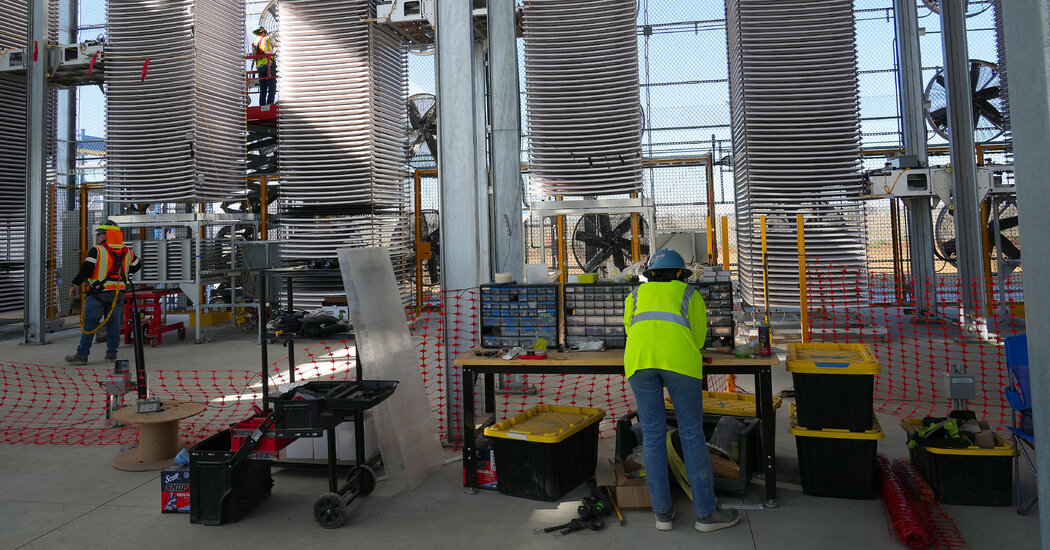- cross-posted to:
- [email protected]
- cross-posted to:
- [email protected]
Trees do it much cheaper.
Yeah, I mean I think carbon capture is kinda stupid on one level. It’s like an excuse for us to not change our behavior
No. Carbon neutral isn’t enough. We are going to have to go carbon negative.
We can’t just take hundreds of millions of years worth of sequestered carbon and dump it into the atmosphere and leave it there to re-sequester itself. That’s going to take a long time to reverse enough to even buck the current trend of global warming, if we were able to just go carbon neutral today.
Trees also don’t really sequester carbon for long. They die, and the carbon gets eaten by organisms and the cycle continues. Or it burns and most of the carbon is released instantly and only ash remain.
Coal only got there specifically because there was nothing evolved to eat lignin for a long time and dead trees piled up so high that dead trees on top ended up compressing their ancestors into it.
Crude only got there because plants and algae in shallow water died, mixed into sediment, rinse, repeat times a few million years, get compressed by the weight of all the layers above, and turn to crude.
The sequestration of ancient carbon wasn’t just by virtue of being plants, but what happened after those plants died.
not only do we need to be carbon negative but we need to move and store more volume than any industry in history … or is it all industry in history. the idea is absurd either way.
It is a historically unprecedented and utterly necessary project. Only a combination of all of the above can even get us close. It’s way too late to be choosy.
Yeah, this is like the inventor that wanted to use floating booms to clean up the ocean… Totally impossible
Picking up trash with a net is a a little easier than collecting 1 trillion tonnes of CO2 from 5.1 quadrillion tonnes of atmosphere, then somehow storing it directly or converting it back into into stable solid or liquid for storage.
It’s not impossible, but in terms of difficulty and expense the two are orders of magnitudes apart from each other. Like “inventing the wheel” vs “landing on the moon.”
I keep hoping some smart environmentalist/entrepreneurs figure out more markets for sequestered carbon. For example how we can use more wood in construction. I just can’t see the right kind of social change happening before it’s too late so hopefully there’s a way to capitalism our way out of this.
I essentially just said the same thing in another reply before I read this one.
I don’t think growing more trees for sequestering is, alone, going to work, due to the sheer scale. Growing trees itself is great. We should totally do that. But for the purpose of sequestering carbon long-term, it’s not that great.
Best we could hope for is a method to discover some new building material that we could manufacture directly from captured atmospheric carbon. Then there is a downstream market for it and the carbon gets “sequestered” as part of our economy of durable goods. Like an alternative to wood, or copper, PVC/PEX, or cement, or steel studs, or rubber, or concrete, or plastic, or hell even girders.
That also would buy us a decade or two, at least, to figure out how to effectively recycle said materials, and be free of a lot of industrial sources of ancient carbon.
Trees also don’t really sequester carbon for long. They die, and the carbon gets eaten by organisms and the cycle continues. Or it burns and most of the carbon is released instantly and only ash remain.
Unless humans get involved and harvest and sequester the tree remains themselves.
Then there still is still a need to expend tons of energy disposing it in a way to not have it re-release in a few hundred thousand years.
The scale is insane to comprehend. We would essentially have to manufacture the equivalent of every pound of coal that’s ever been burned to get to pre-industrial levels, while also consuming as little fossil fuels as possible. I do not think it is possible to do so with trees alone unless we have a lot of cheap green power. Because ultimately some entity, be it government or corporation or philanthropist, will have to pay for it.
And then there is the issue of land rights for where you’re gonna dump all of the captured carbon. That’s a problem either way. I hope we start discovering some new post-space-age reclaimed-carbon-based building materials. That’s probably the best we could hope for. Then there is a huge downstream market for captured carbon which means way less ancient carbon being pulled up into the cycle, and hopefully we can get start regrowing back some old-growth forests and continue to sustainably harvest old wood.
I’m not poo-pooing this technology. It’s super important for us to invest and scale up carbon capture methods. But it can’t be expected to be immediately economically viable. It’s still very immature. Thats not a bad thing. That just means it needs time (and funding) to mature.
Don’t get me wrong — I wasn’t saying it’s a good idea. But absent any fancy technology it’s not entirely impossible to plant fast growing trees, harvest them, and then bury them in a mine or at the bottom of a hypoxic body of water.
It would certainly have to be a global, multi-generational undertaking. But it looks like that’s going to be the case with every other solution as well.
Coal only got there specifically because there was nothing evolved to eat lignin for a long time and dead trees piled up so high that dead trees on top ended up compressing their ancestors into it.
I thought this hypothesis was disproved and it was some geological process that buried the trees? I remember there was a study about lignin content in other fossils and it was compatible with fungi decomposing wood.
The trees got buried in oxygen-free peat bogs where decomposers could not survive.
Yup. It’s a technological antisolution.
An argument is that this is what we should use excess green electricity for. But it does not make sense to run such expensive equipment only a few hours each day. I prefer matching the supply to demand with hydro storage, not to mention that most grids are nowhere near 100% renewable.
Don’t worry, we replaced all the forests with CarbVac™️ facilities. Ensuring a brighter tomorrow, but only if we’re the ones getting paid to do it.
You are right.
But it’s less certain.
There’s a decent amount of carbon emissions associated with management of land, however, and if you want the land to continue to be optimised for carbon sequestration you’ll need to manage it and, besides, in most areas you can’t just buy land, plant some trees on and leave it - it’ll need active management to stay a forest and to comply with local regulation.
But let’s say you’re doing that and planting for carbon sequestration, then you’d probably choose something like pine (fast growing, absorbs a lot of carbon, stays green through the year so tends to prevent competition on the floor). A tree that like will absorb roughly a tonne (1000-1100 kg of carbon) in its life. Then it dies and you’ll need to remove it to ensure a new tree can grow (otherwise it’ll be taken over by other species slowly).
A hectare of dense pine trees can probably hold 3000 trees (if we are being generous) so a hectare (100x100 metres of land) can hold 3000 tonnes of carbon. On average in Europe we emit about 9 tonnes of carbon per year and live for 80 years so a hectare can hold about 4 people’s worth of life time emissions.
In the U.K. you’ll end up spending about £25,000 for a hectare of woodland (give or take), but then you’ll need public liability insurance and management fees (let’s just say £20/year for for a hectare of insurance and £750/year for management of a hectare) … so let’s assume £800/year for a hectare or £200/year to manage the size of woodland required to absorb a person’s life time emissions (remember, 4 people per hectare). Now you need a trust manager who runs it, permanently forevermore, to manage it all. Let’s say £40,000/year and assume that they manage 1000 people’s life time emissions (this obviously could scale down to almost zero as the scheme grew) or £40/year per person.
But don’t forget additionally: This has to be NEW woodland, so you need to buy non-woodland and then plant the woodland. Otherwise you’re not absorbing more carbon. Typical quotes for a hectare of pine planting will be about £4000.
And this cost needs paying forevermore: £6000 to buy the space for a person’s emission £4000 to plant it £250/year to manage it (insurance, management)
To deliver £250/year you’ll need an investment of 250/0.04=£6250. Let’s just say £7000 to leave some buffer for bad years and to pay for the additional carbon that’s emitted from the management. So:
£6000 to buy the space for a person’s emissions. £4000 to plant it.
£7000 to manage it forevermore.So all in you’ll need to spend £17000 to absorb your lifetime’s worth of emissions.
Now let’s compare that to geological sequestration. Climeworks, the only publically available scheme to suck carbon out of the air and sequester it into rock, permanently, quotes £1100/ton of carbon. So to extract the 720 tones you’ll emit in your lifetime it would be £792,000.
So yeah, trees do it a LOT cheaper (2% of the cost), but it requires active management and it’s not guaranteed to be on geological scale.
And I’m not aware of a scheme that enables this to happen. Are you?
Is this one of those situations like solar panels where the tech will get cheaper over time?
No doubt. But we can’t afford to wait. We need it yesterday.
All the more reason to develop the tech then.
I feel like you could do both? carbon capture facility underground with trees ontop and intakes poking through the ground? Wouldn’t even have to burry the facility just build it with a heavy duty roof garden in mind.
Tree roots go down far. You definitely could not run carbon sequestering underneath.
But then again, why would you? Why even bother with sucking it out of the air if trees are so much cheaper? And the added benefit is that you’ll be rewilding land, so it impacts biodiversity too.
As mentioned elswhere in the thread, running a carbon capture plant is something you could just do when renewables are producing excess output which would be more efficient than just winding them down.
Very few renewables are wound down, though. Usually the excess is used to fill pumped storage or turn down hydro plants. For now that’s a viable strategy but soon are exceed renewable will be have to be used someplace else so it’s not a bad idea. I doubt it’ll be enough though.
Trees got solar panels built in you’re not gonna win this one.
If you build enough solar and wind to kick fossils off the grid, they’re going to overproduce at times of peak operation. Rather than wasting that peak production, use it to process CO2.
Also, Canada’s forests burned so hard, they were a net emitter this year. I’m not sure how reliable a carbon sink trees really are as the warming gets worse…
You need nuclear, too. There isn’t enough solar and wind manufacturing and deployment capacity for the foreseeable future to eliminate fossil use. There is no solution to climate change which does not involve significant numbers of new nuclear builds.
Geothermal. It doesn’t matter where you put up those carbon capture facilities. Meaning you could put them in the desert, you could them next to some vulcanos…and so on.
And nuclear builds are a waste of carbon…all that steel and concrete is most of the time not calculated when co2/kwh gets…well, calculated
Wow.
Be more wrong.
Seriously, try; I’ll wait.
They pull it out of the atmosphere, and release it when burned (or rotting etc.).
Far better than putting new co2 in the atmosphere.
Sure is a shame there’s so many scams related to that area. In theory, planting or protecting forests is one of the best things we can do. But in practice? A lot of organizations that claim to protect some area from industrialization are actually protecting an area that was never at risk in the first place. That is, if they didn’t exist, the forest would be unchanged. Others are only protected for short periods of time. https://youtu.be/AW3gaelBypY?si=56uG8zf1iAeJM31H
Here is an alternative Piped link(s):
https://piped.video/AW3gaelBypY?si=56uG8zf1iAeJM31H
Piped is a privacy-respecting open-source alternative frontend to YouTube.
I’m open-source; check me out at GitHub.
deleted by creator
Form a Fortune article:
While Heirloom declined to disclose the price tag to build the California facility, the company aims to operate at a cost of $100 per ton of carbon removed by 2030
From a Techwire article:
Heirloom estimates that the current cost of the technology ranges from $600 to $1,000 per ton of CO2 removed.
I could not find any article on how much the carbon cost was to run such a facility and move the raw materials to/from it.
Well, they’re using renewable energy to power it. The limestone looks like it’s just constantly recycled, so it would be just the initial transport there. Their output is tanks of compressed carbon dioxide which is sent to a concrete maker, so it really depends on how far away the concrete maker is. There’s a thing called industrial symbiosis, where manufacturers co-locate so that one factory’s waste easily becomes the factory next door’s input.
I’m not very familiar with all this but shouldn’t we be hiding the CO2 somehow? I feel like concrete is just going to nudge the can down the road until it breaks down in like 50 years
While in 50 years it might not be a great building anymore, it will still be a fantastic pile of rubble. Basically landfill, but it can be reused as gravel for new building projects, too.
That all makes sense, thank you!
The concrete frkm the berlin wall is probably being used in some industrial parking lot somewhere.
The concrete won’t release the CO2 when it breaks down, since the quicklime in the cement reacts with CO2 to form limestone. The catch is that quicklime is mainly produced by heating limestone to release CO2, so making extra concrete won’t result in net carbon capture. But if the concrete was going to be produced anyway, I suppose it’s better to have it absorb the CO2 sooner rather than later.
Hmm, well that’s less exciting than I had hoped but yeah at least it is something and honestly anything to get new tech funded is probably good overall
Roman concrete structures still exist after 2000 years. If you want to “hide” the CO2 somehow, then concrete doesn’t seem like a bad idea.
To earn revenue, the company is selling carbon removal credits to companies paying a premium to offset their own emissions. Microsoft has already signed a deal with Heirloom to remove 315,000 tons of carbon dioxide from the atmosphere.
And this is why direct air capture is a farce right now - any progress they make is literally counter acted by large corporations who will increase their carbon output because they have a contract with a company like this.
Carbon air capture technology paired with 100% clean energy can save the world from a lot of hardship in the near future, but not like this.
I think it’s the opposite. This paves the way to enforce companies to pay to remove the carbon they emit. If this can be profitable then there is room to invest on improvements making it more feasible at large scale.
bro im starting one of these companies
Do you think Microsoft was holding back expanding its business because if carbon output?
They took all the trees and put them in a tree museum.
They paved paradise and put up a parking lot.
Ok Joni
This is the best summary I could come up with:
In an open-air warehouse in California’s Central Valley, 40-foot-tall racks hold hundreds of trays filled with a white powder that turns crusty as it absorbs carbon dioxide from the sky.
The start-up that built the facility, Heirloom Carbon Technologies, calls it the first commercial plant in the United States to use direct air capture, which involves vacuuming greenhouse gases from the atmosphere.
Critics point out that many artificial methods of removing carbon dioxide from the air are wildly expensive, in the range of $600 per ton or higher, and some fear they could distract from efforts to reduce emissions.
In an attempt to build confidence in the market, the Energy Department in September announced it would buy $35 million worth of carbon removal credits from up to 10 providers, in order to establish new guidelines around what counts as a “high quality” project.
“There’s a big difference between exploring an infant technology to see if it can be developed, versus telling the public, ‘If we do this, we can continue burning fossil fuels forever,’” former Vice President Al Gore said at a recent New York Times event.
The debate over how big a role carbon removal should play in tackling climate change is still in early stages, said Emily Grubert, associate professor of sustainable energy policy at the University of Notre Dame.
The original article contains 1,647 words, the summary contains 222 words. Saved 87%. I’m a bot and I’m open source!
Wouldn’t it be more efficient to use algae for that and stuff the slime directly in the borehole?
Possible not, you need to maintain the growth conditions for the algae, that has some meaningful energy cost.
Glass panel over it for greenhouse?
Can’t use more power than carbon skimming.
I actually helped research this as an undergrad. The problem we’d always face is there are certain microorganisms, like rotifers, that can just decimate a tank of algae. Many rotifer species are parthenogenic, so it literally only takes one rotifer to knock out an entire algae tank.
What if we genetically modified the algae to be impossible to kill and survive in extreme conditions. Like the algae equivalent of kudzu.
Now coming to everyone soon: algae world! All algae all the time! Covered in slime? That’s worth a dime! There is no escaping it, not even a bit.
It’ll be fine.
If it gets out of hand we’ll just engineer an equally hardy and aggressive rotifer to kill all the algae.
You’re basically exchanging a world-ending Gray Goo Scenario for a world-ending Green Goo Scenario.
You need more than a green house lol.
I only ever had problems with too much algae in our pond…
You’ve figured it out.
Unfortunately I can’t read the article. What do they do with the carbon once it’s collected? How are these powered? How much power does the collector use compared to how much it collects? If stored, where and how?
At the California plant, workers heat limestone to 1,650 degrees Fahrenheit in a kiln powered by renewable electricity. Carbon dioxide is released from the limestone and pumped into a storage tank.
The leftover calcium oxide, which looks like flour, is then doused with water and spread onto large trays, which are carried by robots onto tower-high racks and exposed to open air. Over three days, the white powder absorbs carbon dioxide and turns into limestone again. Then it’s back to the kiln and the cycle repeats.
“That’s the beauty of this, it’s just rocks on trays,” Mr. Samala, who co-founded Heirloom in 2020, said. The hard part, he added, was years of tweaking variables like particle size, tray spacing and moisture to speed up absorption.
The carbon dioxide still needs to be dealt with. In California, Heirloom works with CarbonCure, a company that mixes the gas into concrete, where it mineralizes and can no longer escape into the air. In future projects, Heirloom also plans to pump carbon dioxide into underground storage wells, burying it.
So they’re using the “limestone -> quicklime -> slaked lime -> limestone” cycle. The kiln must be powered by renewables (otherwise the process is pointless), but it’s a perfectly reasonable capture method.
Storage is slightly less straightforward. Concrete naturally absorbs carbon dioxide over decades, mixing carbon dioxide in during production is just accelerating the inevitable.
Additionally, the reason concrete can absorb carbon dioxide is that cement contains quicklime, which is mainly produced by… you guessed it, heating limestone to release the carbon dioxide! The concrete won’t absorb more carbon dioxide than was released during its production, so making excess concrete is not a solution to CO2 capture. However, if the concrete was going to be produced anyway (and we produce a lot), I suppose it’s slightly better to have it absorb carbon dioxide sooner rather than later.
Pumping carbon dioxide into underground storage wells a more scalable solution, provided that the local geology (olivine?) can absorb the carbon dioxide.
An alternative not discussed in the article is to reduce the carbon dioxide into various feedstock chemicals that we currently derive from fossil fuels. Again, this would need to be powered by renewables otherwise the process is pointless.
You a wonderful. Thank you for this.
You’re welcome!
absolute bullshit, it burns more in carbon to run those machines than it takes out, this is making shit worse at an accelerated pace
You might want to read the article more carefully.
At the California plant, workers heat limestone to 1,650 degrees Fahrenheit in a kiln powered by renewable electricity.
Direct-air carbon capture has its fair share of problems to overcome before it can become a practical solution, but any such process must obviously be powered by renewables. To do otherwise would be pointless.

















